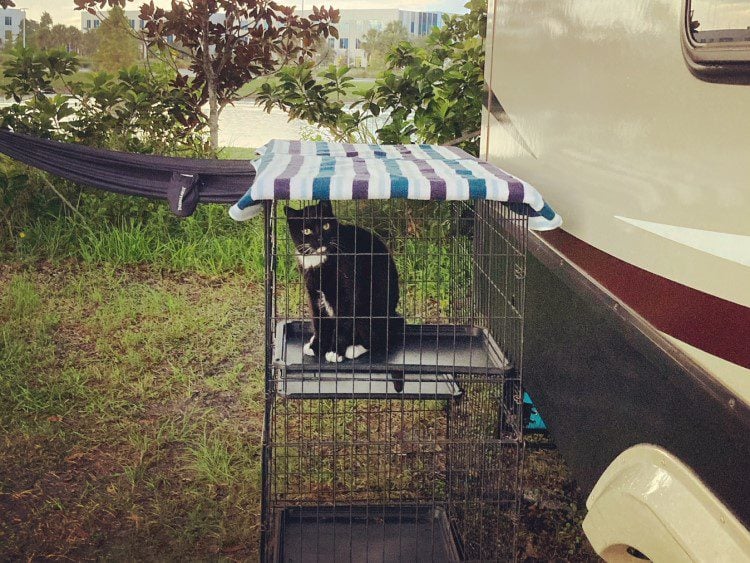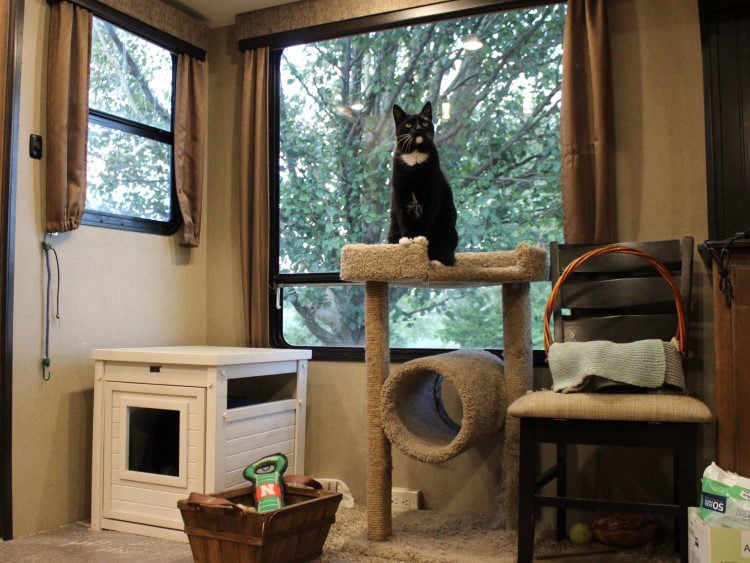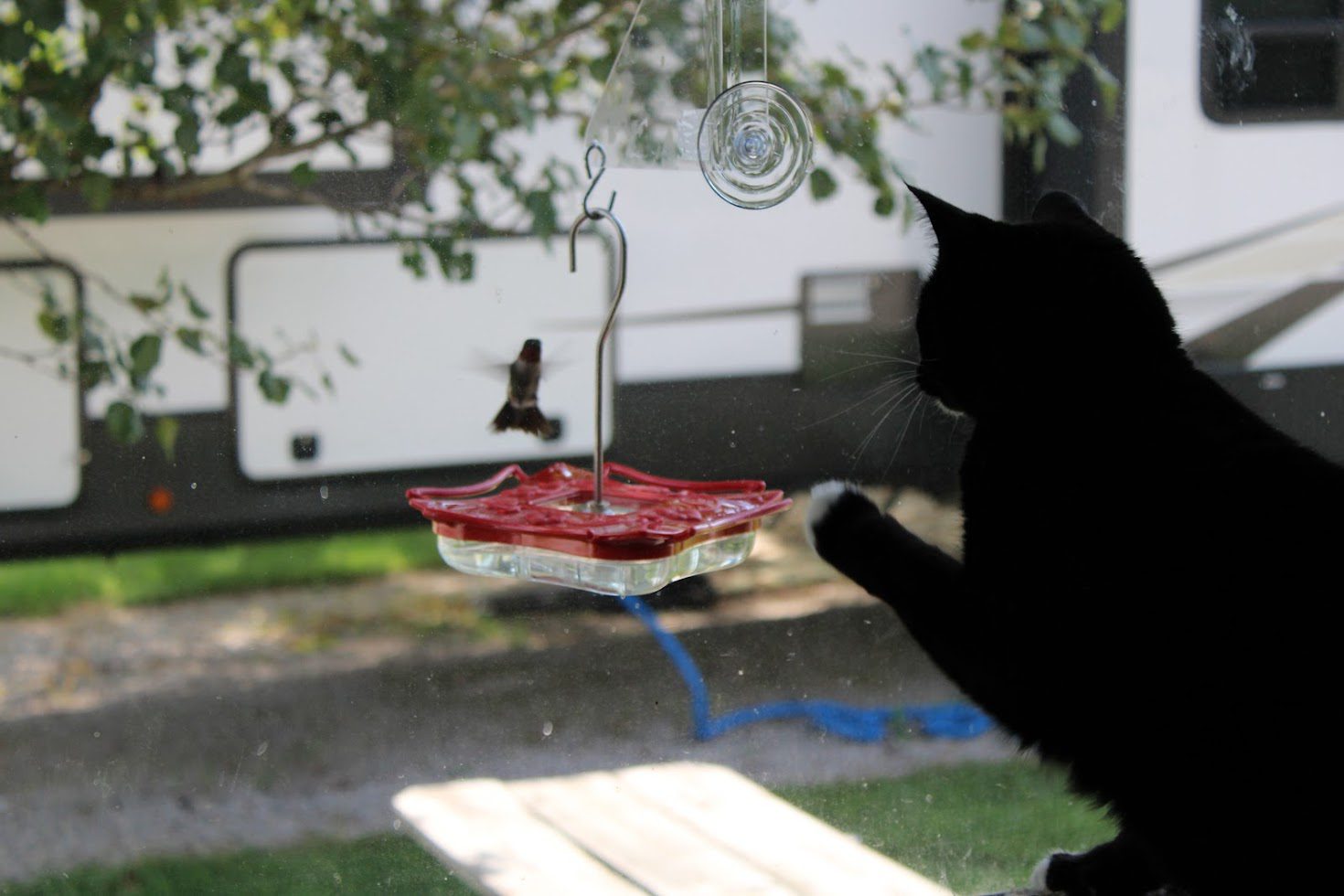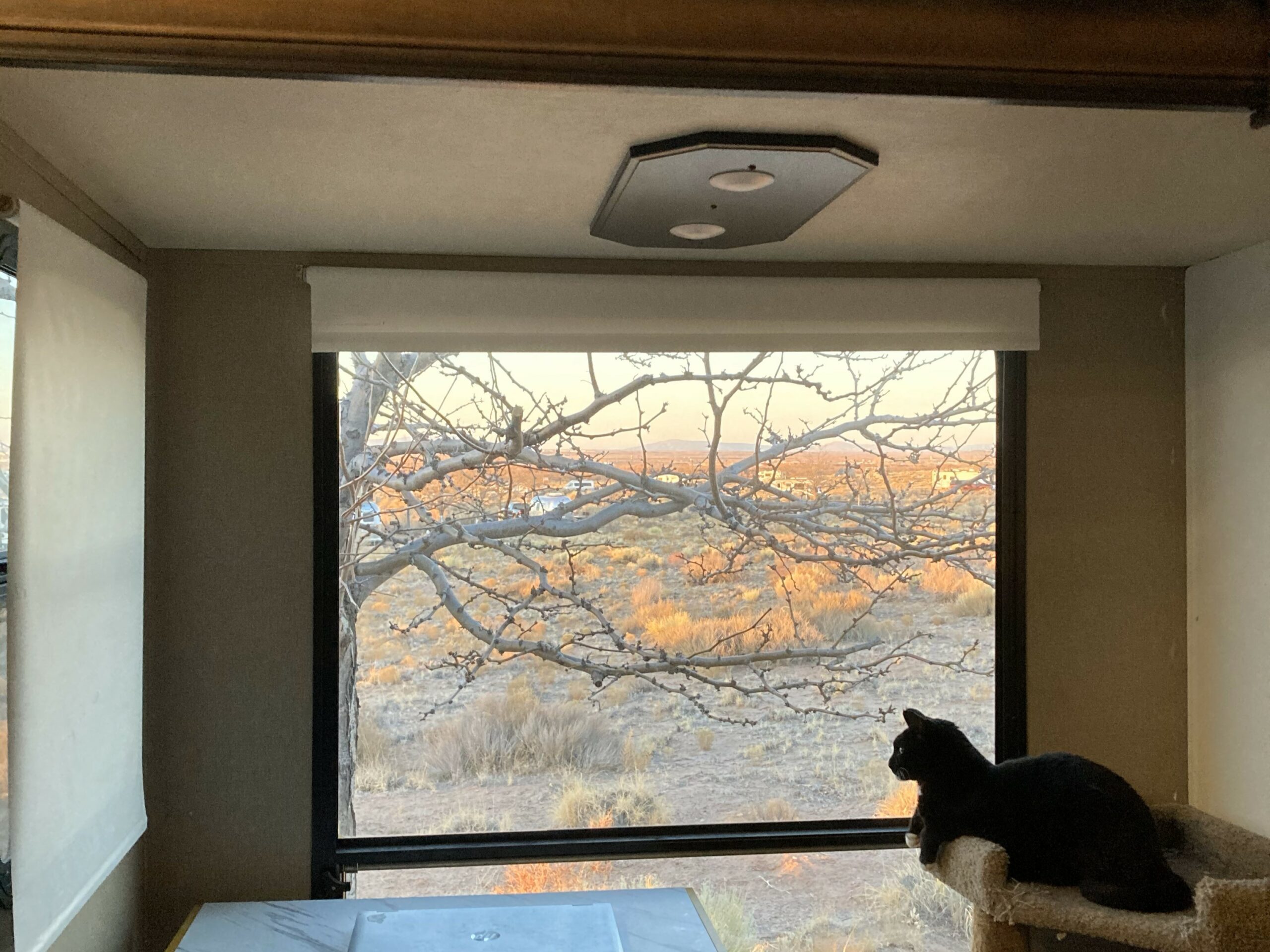This post may contain affiliate links. See our affiliate disclaimer here.
When we decided to move into an RV full-time, there was no question that our dog (Ted) and cat (Mr. Man) would join us on the road. However, traveling with a cat has definitely been a bit more challenging than traveling with a dog.
Cats require more stuff, like a litter box and scratching post. After several years on the road, we’ve learned a great deal about RV travel with cats. Below are our key tips on full-time RV living with cats.
Contents
RV Travel with Cats

How your cat travels will depend on their temperament and if they get car sick. When we first started traveling with our fifth wheel, we placed Mr. Man in his carrier in the back seat of the truck.
After listening to him howling for over two hours, we knew we were going to have to let him out of the carrier. Then, we encountered our second problem, Mr. Man started getting car sick and throwing up a few hours into each road trip.
We now give him Dramamine thirty minutes before hitting the road to prevent sickness and let him use the center console of our truck as his bed while we travel. We have found Dramamine to be very effective, but you should consult with your vet and ask them for the proper dosage before giving any medicine to your cat.
If your cat is not docile in the car or if you can’t trust them not to try to climb on the driver, keep them in a secure carrier while driving.
Travel is a big part of full-time RV living with cats, and it will likely take some trial and error to figure out the right spot in your truck or motorhome. Start with shorter drives to allow time to evaluate the best travel arrangements for your cat(s).
You also need to consider access to the litter box while traveling. Given that Mr. Man has a sensitive stomach, we leave the litter box in the backseat of our tow truck. Traveling with a smelly box is not ideal, but it is easier than trying to stop for potty breaks.
If you do not travel with a litter box in your tow vehicle, you should allow the cat access to the litter box in the RV every few hours. You can shut your cat in the bathroom with the litter box, so they can’t hide from you to avoid returning to the truck.
RV Pet Enclosures

Mr. Man made it clear he wanted to be outside from day one living in the RV. He would jump over our heads when we opened the door. After some time, he even figured out how to open the screen door with his paw.
We were happy to let him outside but did not want to let him roam freely given the large number of cars and dogs in most RV parks. Our first attempts at outdoor time involved harnesses and leashes.
However, Mr. Man escaped from every one of these contraptions including the harness that was advertised even “ninja cats” could not escape it.
Next, we tried a few soft-sided cat enclosures. These worked pretty well at containing Mr. Man but they got destroyed pretty quickly from his scratching and playing.
Finally, we purchased this collapsible, metal cat kennel and it has been a great solution. Mr. Man loves to go in his new enclosure. The multiple levels keep him entertained and we are happy knowing he is secure and can’t escape.
How to Keep Cats in an RV

As noted above, our cat and many other RV cats try to escape the RV in order to explore outside. Learning how to keep your kitty safely inside is one of the most important aspects of RV living with cats.
Many cats are able to escape the RV when the main door is open and the screen door is being used. Fortunately, these escapes are easy to prevent either by keeping the door shut or installing a lock on the screen door.
Mr. Man has also successfully escaped the RV several times when we are entering or exiting. If your cat is eager to go outside, be vigilant when opening the door.
If you are concerned about your cat trying to run outside on travel days, keep them in a carrier in the RV or tow vehicle. Ideally, RV cats should be microchipped for easy tracking in case they are lost.
The RV Litter Box

Where do you put a litter box when you are RV living with cats? There are several options, but it is definitely best if you can account for the litter box when you are shopping for RVs and selecting the best floor plan for your family.
Many RVers place the litter box in the shower, but we found this not to be an ideal solution. Moving the box every time we showered and trying to keep litter from going down the drain was frustrating.
We tried a few solutions before finding the perfect spot for Mr. Man’s litter box. After nixing the shower solution, we removed our dinette table and placed a litter box cabinet in that space. Later, I wanted to use the dinette space for an office, so we created a litter box room under the steps in the storage bay of our fifth wheel.
For full-time RV living with cats, make sure to purchase a litter box with a lid to limit odor and tracking of litter. In a small space, you are also going to want to shell out the extra money for quality cat litter that reduces odor and clean the box at least once each day.
Keeping Cats Happy in an RV

When considering RV living with cats, many pet owners are concerned about keeping their cats happy in the RV. Even though space is limited, it is important to provide entertainment and activities to keep your cat happy and healthy.
I strongly recommend finding a spot in the RV for a small cat condo or cat tree. We removed our dinette to create a space for Mr. Man’s cat tree and this is a great option to create space in many RVs.
Also, bring along any items your cat was particularly attached to in your previous home. While downsizing is important for full-time RVers, pet’s comfort items should always make the “keep” list. Bring your cat’s bowls, toys, and beds to help them feel at home in their new space.
Vet Visits and Vaccination Records

When we first moved into our RV, we tried to keep all of our annual vet check-ups and vaccination appointments in our previous home in Raleigh, NC. However, we soon realized different vaccinations are needed at different times of the year and it is not realistic to use a single provider.
Now, we take our cat, Mr. Man, to the nearest local vet that has positive reviews online. To keep his records organized, we ask each vet to print out a hard copy of the vaccination and check-up report.
We store these hard copies in our glove compartment so they are easily accessible. I also take a picture of the record and save a digital copy in case hard copies are lost.
Unfortunately, accidents happen while traveling, so you need to be prepared to find vet care nearby. Each time you visit a new location, identify the closest emergency vet.
Write down the phone number and address, so you are ready to go if your cat has an emergency. At the same time, also find the nearest hospital, storm shelter, and mobile RV service.
Living full-time in an RV with cats can be an incredibly rewarding experience. With the right preparation, patience, and a few clever hacks, you and your feline friends can thrive on the road. From choosing the right litter box to creating safe spaces for your cat, every small step makes a big difference in keeping them happy and stress-free.
Happy Camping!

Christina Pate is a seasoned full-time RVer who, along with her husband Justin, has journeyed across the US, Canada, and Mexico. Drawing from her extensive travels, RV repairs and RV renovations, she founded Travels with Ted to guide and inspire fellow RV enthusiasts. Christina is also the co-author of The Owner’s Guide to RV Maintenance and the creator of My RV Log Book.

